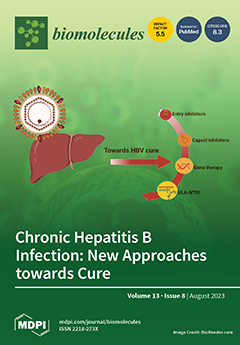Open AccessEditor’s ChoiceArticle
Circulating H3K27 Methylated Nucleosome Plasma Concentration: Synergistic Information with Circulating Tumor DNA Molecular Profiling
by
Emmanuel Grolleau, Julie Candiracci, Gaelle Lescuyer, David Barthelemy, Nazim Benzerdjeb, Christine Haon, Florence Geiguer, Margaux Raffin, Nathalie Hardat, Julie Balandier, Rémi Rabeuf, Lara Chalabreysse, Anne-Sophie Wozny, Guillaume Rommelaere, Claire Rodriguez-Lafrasse, Fabien Subtil, Sébastien Couraud, Marielle Herzog and Lea Payen-Gay
Cited by 2 | Viewed by 2185
Abstract
The molecular profiling of circulating tumor DNA (ctDNA) is a helpful tool not only in cancer treatment, but also in the early detection of relapse. However, the clinical interpretation of a ctDNA negative result remains challenging. The characterization of circulating nucleosomes (carrying cell-free
[...] Read more.
The molecular profiling of circulating tumor DNA (ctDNA) is a helpful tool not only in cancer treatment, but also in the early detection of relapse. However, the clinical interpretation of a ctDNA negative result remains challenging. The characterization of circulating nucleosomes (carrying cell-free DNA) and associated epigenetic modifications (playing a key role in the tumorigenesis of different cancers) may provide useful information for patient management, by supporting the contributive value of ctDNA molecular profiling. Significantly elevated concentrations of H3K27Me3 nucleosomes were found in plasmas at the diagnosis, and during the follow-up, of NSCLC patients, compared to healthy donors (
p-value < 0.0001). By combining the H3K27Me3 level and the ctDNA molecular profile, we found that 25.5% of the patients had H3K27Me3 levels above the cut off, and no somatic alteration was detected at diagnosis. This strongly supports the presence of non-mutated ctDNA in the corresponding plasma. During the patient follow-up, a high H3K27Me3-nucleosome level was found in 15.1% of the sample, despite no somatic mutations being detected, allowing the identification of disease progression from 43.1% to 58.2% over molecular profiling alone. Measuring H3K27Me3-nucleosome levels in combination with ctDNA molecular profiling may improve confidence in the negative molecular result for cfDNA in lung cancer at diagnosis, and may also be a promising biomarker for molecular residual disease (MRD) monitoring, during and/or after treatment.
Full article
►▼
Show Figures






